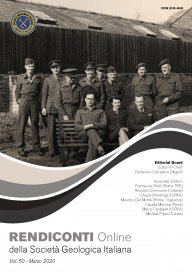
A look beyond color: a multi-analytical approach to the study of the frescoes from “Porta Mediana†A41 mausoleum (Cuma necropolis- Italy)
Claudia Di Benedetto (1), Sossio Fabio Graziano (2), Concetta Rispoli (1), Alberto De Bonis (1), Priscilla Munzi (3), Piergiulio Cappelletti (1,4) & Vincenzo Morra (1)
(1) DiSTAR - Dipartimento di Scienze della Terra, dell'Ambiente e delle Risorse - Università di Napoli Federico II, Via Cintia, 26 – 80126, Napoli. (2) Dipartimento di Farmacia - Università di Napoli Federico II, Via D. Montesano, 49 – 80131, Napoli, Italy.
(3) Centre Jean Bérard, USR 3133 CNRS - École française de Rome, Via Francesco Crispi, 86 – 80121, Napoli, Italy.
(4) Centro Musei delle Scienze Fisiche e Naturali – Università di Napoli FEDERICO II, via Mezzocannone, 8 -80134, Napoli, Italy.
Corresponding author e-mail: claudia.dibenedetto@unina.it
Volume: 50/2020
Pages: 67-75
Abstract
This research is part of the PON (Programma Operativo Nazionale) SINAPSIS (SIstema NAzionale Protezione SIti Sensibili), an interdisciplinary project combining archaeological and archaeometric methods.
This paper focuses on frescoes from one of the 70 funeral monuments belonging to “Porta Mediana” Necropolis, a very interesting archaeological context located in Cuma, dating back to the first half of the 3rd century BCE. The study provided detailed information on pigments and colors acquired both on untreated and treated (restored) frescoes.
Portable colorimetry and chemical-mineralogical (Raman spectroscopy and X-ray powder diffraction – XRPD, respectively) analyses were performed in situ and on collected samples in order to: 1) identify pigments, raw materials and provenance, 2) point out possible color changes caused by conservative treatments and/or weathering.
The identified palette is typical of the Roman period; it includes both single and mixtures of two or more pigments to obtain particular hues. Moreover, the identified raw materials, such as red and yellow ochres, green frit and Egyptian blue, clearly highlighted the choice to use raw materials from local sources. The use of expensive coloring materials also suggests that the mausoleum belonged to a family or a group of people with a high social status.
Keywords
Get Full Text